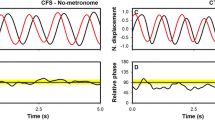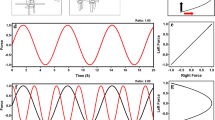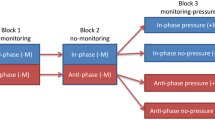Summary
A theoretical framework is outlined, according to which structural constraints on bimanual movements can at least in part be understood as coupling between parameters of generalized motor programs. This framework provides a conceptual link between reaction-time data from experiments with bimanual responses, successive unimanual responses, and choice between left-hand and right-hand responses on the one hand and performance data obtained with concurrently performed continuous movements or sequences of discrete responses on the other. On the basis of data obtained with different methods for the study of intermanual interactions, a distinction is drawn between steady-state and transient constraints, and the hypothesis that the tendency to coactivate homologous muscles originates from a transient coupling of program parameters is applied to a variety of observations on performance in different tasks. Finally, the notion of transient constraints is applied to other types of intermanual interdependencies and to interpersonal coordination; the possible emergence of transient constraints from steady-state constraints through progressive development of inhibitory pathways in childhood is discussed, as is the potential biological significance of transient constraints.
Similar content being viewed by others
References
Abernethy, B., & Sparrow, W. A. (1992). The rise and fall of dominant paradigms in motor behaviour research. In J. J. Summers (Ed.), Approaches to the study of motor control and learning (pp. 3–45). Amsterdam: North-Holland.
Basmajian, J. V. (1977). Motor learning and control: A working hypothesis. Archives of Physical Medicine and Rehabilitation, 58, 38–41.
Basmajian, J. V. (1978). Muscles alive. Their functions revealed by electromyography (4th Ed.). Baltimore: Williams & Wilkins.
Bullock, D., & Grossberg, S. (1988). Neural dynamics of planned arm movements: Emergent invariants and speed-accuracy properties during trajectory formation. Psychological Review, 95, 49–90.
Bullock, D., & Grossberg, S. (1991a). Adaptive neural networks for control of movement trajectories invariant under speed and force resealing. Human Movement Science, 10, 3–53.
Bullock, D., & Grossberg, S. (1991b). Reply to comments on “Adaptive neural networks for control of movement trajectories invariant under speed and force resealing”. Human Movement Science, 10, 133–157.
Burns, D. (1968). The uncertain nervous system. London: Arnold.
Chang, P., & Hammond, G. R. (1987). Mutual interactions between speech and finger movements. Journal of Motor Behavior, 19, 265–274.
Cohen, L. (1971). Synchronous bimanual movements performed by homologous and nonhomologous muscles. Perceptual and Motor Skills, 32, 639–644.
Corcos, D. M. (1984). Two-handed movement control. Research Quarterly for Exercise and Sport, 55, 117–122.
Cruse, H. (1986). Constraints for joint angle control of the human arm. Biological Cybernetics, 54, 125–132.
Cruse, H., Dean, J., Heuer, H., & Schmidt, R. A. (1990). Utilization of sensory information for motor control. In O. Neumann & W. Prinz (Eds.), Relationships between perception and action. Current approaches (pp. 43–79). Berlin: Springer.
Decety, J., & Ingvar, H. (1990). Brain structures participating in mental simulation of motor behavior: A neuropsychological interpretation. Acta Psychologica, 73, 13–34.
Drill, R. (1933). Der Hammersehlag. Neue Psychologische Studien, 9, 139–208.
Drillis, R. J. (1959). The use of gliding cyclograms in biomechanical analysis of movement. Human Factors, 1(2), 1–11.
Fowler, B., Duck, T., Mosher, M., & Mathieson, B. (1991). The coordination of bimanual aiming movements: Evidence for progressive desynchronization. Quarterly Journal of Experimental Psychology, 43A, 205–221.
Ghez, C., Hening, W., & Favilla, M. (1990). Parallel interacting channels in the initiation and specification of motor response features. In M. Jeannerod (Ed.), Attention and performance XIII (pp. 265–293). Hillsdale, NJ: Erlbaum.
Grice, G. R., Nullmeyer, R., & Spiker, V. A. (1977). Application of variable criterion theory to choice reaction time. Perception & Psychophysics, 22, 431–449.
Gunkel, M. (1962). Über relative Koordination bei willkürlichen menschlichen Gliederbewegungen. Pfl ügers Archiv für die gesamte Physiologie, 275, 472–477.
Haken, H., Kelso, J. A. S., & Bunz, H. (1985). A theoretical model of phase transitions in human hand movements. Biological Cybernetics, 51, 347–356.
Heuer, H. (1982a). Binary choice reaction time as a criterion of motor equivalence. Acta Psychologica, 50, 35–47.
Heuer, H. (1982b). Binary choice reaction time as a criterion of motor equivalence: Further evidence. Acta Psychologica, 50, 48–60
Heuer, H. (1982c). Choice between finger movements of different and identical forms: The effect of relative signal frequency. Psychological Research, 44, 323–342.
Heuer, H. (1984). Binary choice reaction time as a function of the relationship between durations and forms of responses. Journal of MotorBehavior, 16, 392–404.
Heuer, H. (1985). Intermanual interactions during simultaneous execution and programming of finger movements. Journal of Motor Behavior, 17, 335–354.
Heuer, H. (1986a). Intermanual interactions during programming of aimed movements: Converging evidence for common and specific parameters of control. Psychological Research, 48, 37–46.
Heuer, H. (1986b). Intermanual interactions during programming of finger movements: Transient effects of “homologous coupling”. In H. Heuer & C. Fromm (Eds.), Generation and modulation of action patterns (pp. 87–101). Berlin: Springer.
Heuer, H. (1987). Visual discrimination and response programming. Psychological Research, 49, 91–98.
Heuer, H. (1989). A multiple-representations' approach to mental practice of motor skills. In B. Kirkcaldy (Ed.), Normalities and abnormalities in human movement (pp. 36–57). Basel: Karger.
Heuer, H. (1990a). Rapid responses with the left or right hand: Response-response compatibility effects due to intermanual interactions. In: R. W. Proctor & T. G. Reeve (Eds.), Stimulus-response compatibility. An integrated perspective. Amsterdam: North-Holland.
Heuer, H. (1990b). Psychomotorik. In H. Spada (Ed.), Lehrbuch AllgemeinePsychologie (pp. 495–559). Bern: Huber.
Heuer, H. (1991a). Invariant relative timing in motor-program theory. In J. Fagard & P. H. Wolff (Eds.), The development of timing control and temporal organization in coordinated action. Invariant relative timing, rhythms, and coordination (pp. 37–68). Amsterdam: NorthHolland.
Heuer, H. (1991b). Some characteristics of VITE. Human Movement Science, 10, 55–64.
Heuer, H. (in press). Coordination. In H. Heuer & S. W. Keele (Eds.), Handbook of perception and action: Motor skills. New York: Academic Press.
Hogan, N. (1984). An organizing principle for a class of voluntary movements. Journal of Neuroscience, 4, 2745–2754.
Kalveram, K.-Th. (1991a). Pattern generating and reflex-like processes controlling aiming movements in the presence of inertia, damping and gravity. Biological Cybernetics, 64, 413–419.
Kalveram, K.-Th. (1991b). Controlling the dynamics of a two-jointed arm by central patterning and reflex-like processing. A two-stage hybrid model. Biological Cybernetics, 65, 65–71.
Kelso, J. A. S. (1984). Phase transitions and critical behavior in human bimanual coordination. American Journal of Physiology: Regulatory, Integrative, and Comparative, 246, R1000-R1004.
Kelso, J. A. S., & Scholz, J. P. (1985). Cooperative phenomena in biological motion. In H. Haken (Ed.), Complex systems: Operational approaches in neurobiology, physical systems and computers (pp. 124–149). Berlin: Springer.
Kelso, J. A. S., & Schöner, G. (1988). Self-organization of coordinatioe movement patterns. Human Movement Science, 7, 27–46.
Kelso, J. A. S., Southard, D. L., & Goodman, D. (1979). On the coordination of two-handed movements. Journal of Experimental Psychology: Human Perception and Performance, 5, 229–238.
Kelso, J. A. S., Tuller, B., & Harris, K. S. (1983). A “dynamic pattern” perspective on the control and coordination of movement. In P. F. MacNeilage (Ed.), The production of speech (pp. 137–173). Berlin: Springer.
Kuhn, T. S. (1970). The structure of scientific revolutions (2nd Ed.). Chicago: University of Chicago Press.
MacKay, D. G., & Soderberg, G. A. (1971). Homologous intrusions: An analogue of linguistic blends. Perceptual and Motor Skills, 32, 645–646.
Marteniuk, R. G., & MacKenzie, C. L. (1980). A preliminary theory of two-hand coordinated control. In G. E. Stelmach & J. Requin (Eds.), Tutorials in motor behavior (pp. 185–197). Amsterdam: NorthHolland.
McCormick, E. J. (1970). Human factors engineering (3rd ed.). New York: McGraw-Hill.
Meijer, O. G., & Roth, K., Eds. (1988). Complex movement behavior. “The” motor-action controversy. Amsterdam: North-Holland.
Miller, J. O. (1988). Discrete and continuous models of human information processing: Theoretical distinctions and empirical results. Acta Psychologica, 67, 191–257.
Nelson, W. L. (1983). Physical principles for economies of skilled movements. Biological Cybernetics, 46, 135–147.
Newland, D. E. (1986). An introduction to random vibrations and spectral analysis (2nd ed.). New York: Longman.
Norrie, M. L. (1964). Timing of two simultaneous movements of arms and legs. Research Quarterly, 35, 511–522.
Norrie, M. L. (1967). Effects of unequal distances and handedness on timing patterns for simultaneous movements of arms and legs. Research Quarterly, 38, 241–246.
Peters, M. (1977). Simultaneous performance of two motor activities: The factor of timing. Neuropsychologia, 15, 461–465.
Peterson, J. R. (1965). Response-response compatibility effects in a two-hand pointing task. Human Factors, 7, 231–236.
Rabbitt, P. M. A., Vyas, S. M., & Fearnley, S. (1975). Programming sequences of complex responses. In P. M. A. Rabbitt & S. Dornic (Eds.), Attention and performance V. London: Academic Press.
Rosenbaum, D. A. (1985). Motor programming: A review and a scheduling theory. In H. Heuer, U. Kleinbeck, & K.-H. Schmidt (Eds.), Motor behavior. Programming, control, and acquisition (pp. 1–33). Berlin: Springer.
Rosenbaum, D. A., & Kornblum, S. (1982). A priming method for investigating the selection of motor responses. Acta Psychologica, 51, 223–243.
Saltzman, E. (1986). Task dynamic coordination of the speech articulators: A preliminary model. In H. Heuer & C. Fromm (Eds.), Generation and modulation of action patterns (pp. 129–144). Berlin: Springer.
Saltzman, E., & Kelso, J. A. S. (1987). Skilled actions: A task-dynamic approach. Psychological Review, 94, 84–106.
Sanders, A. F. (1990). Issues and trends in the debate on discrete vs. continuous processing of information. Acta Psychologica, 74, 123–167.
Schmidt, R. A. (1980). On the theoretical status of time in motorprogram representations. In G. E. Stelmach & J. Requin (Eds.), Tutorials in motor behavior (pp. 145–165). Amsterdam: NorthHolland.
Schmidt, R. A. (1985). The search for invariance in skilled movement behavior. Research Quarterly for Exercise and Sport, 56, 188–200.
Schmidt, R. A., Zelaznik, H. N., Hawkins, B., Frank, J. S., & Quinn, J. T. (1979). Motor-output variability. A theory for the accuracy of rapid motor acts. Psychological Review, 86, 415–451.
Schmidt, R. C., Carello, C., & Turvey, M. T. (1990). Phase transitions and critical fluctuations in the visual coordination of rhythmic movements between people. Journal of Experimental Psychology: Human Perception and Performance, 16, 227–247.
Scholz, J. P., & Kelso, J. A. S. (1989). A quantitative approach to understanding the formation and change of coordinated movement patterns. Journal of Motor Behavior, 21, 122–144.
Schöner, G. (1990). A dynamic theory of coordination of discrete movement. Biological Cybernetics, 63, 257–270.
Schöner, G., & Kelso, J. A. S. (1988a). A synergetic theory of environmentally-specified and learned patterns of movement coordination. I: Relative phase dynamics. Biological Cybernetics, 58, 71–80.
Schöner, G., & Kelso, J. A. S. (1988b). A synergetic theory of environmentally-specified and learned patterns of movement coordination. II: Component oscillator dynamics. Biological Cybernetics, 58, 81–89.
Summers, J. J. (1989). Motor programs. In D. H. Holding (Ed.), Human skills (2nd ed.) (pp. 49–69). Chichester: Wiley.
Summers, J. J., Bell, R., & Burns, B. D. (1989). Perceptual and motor factors in the imitation of simple temporal patterns. Psychological Research, 51, 23–27.
Swinnen, S., Walter, C. B., & Shapiro, D. C. (1988). The coordination of limb movements with different kinematic patterns. Brain and Cognition, 8, 326–347.
Taniguchi, R., Nakamura, R., & Oshima, Y. (1977). Reaction time in simultaneous motions. Perceptual and Motor Skills, 44, 709–710.
Uno, Y., Kawato, M., & Suzuki, R. (1989). Formation and control of optimal trajectory in human multijoint arm movement: Minimum torque-change model. Biological Cybernetics, 61, 89–101.
Vickers, D. (1979). Decision processes in visual perception. New York: Academic Press.
Viviani, P. (1986). Do units of motor action really exist? In H. Heuer & C. Fromm (Eds.), Generation and modulation of action patterns(pp. 201–216). Berlin: Springer.
von Hofsten, C. (1987). Catching. In H. Heuer & A. F. Sanders (Eds.), Perspectives on perception and action (pp. 33–46). Hillsdale, NJ: Erlbaum.
von Holst, E. (1939). Die relative Koordination als Phänomen und als Methode zentralnervöser Funktionsanalyse. Ergebnisse der Physiologie, 42, 228–306.
Wakelin, D. R. (1976). The role of the response in psychological refractoriness. Acta Psychologica, 40, 163–175.
Wolff, P. H., Gunnoe, C. E., & Cohen, C. (1983). Associated movements as a measure of developmental age. Developmental Medicine and Child Neurology, 25, 417–429.
Yamanishi, J., Kawato, M., & Suzuki, R. (1980). Two coupled oscillators as a model of the coordinated finger tapping by both hands. Biological Cybernetics, 37, 219–225.
Zattara, M., & Bouisset, S. (1986). Chronometric analysis of the posturo-kinetic programming of volutary movement. Journal of Motor Behavior, 18, 215–223.
Author information
Authors and Affiliations
Additional information
Part of the work reported in this paper was done while I enjoyed the hospitality on the NIAS, Wassenaar (NL)
Rights and permissions
About this article
Cite this article
Heuer, H. Structural constraints on bimanual movements. Psychol. Res 55, 83–98 (1993). https://doi.org/10.1007/BF00419639
Issue Date:
DOI: https://doi.org/10.1007/BF00419639




